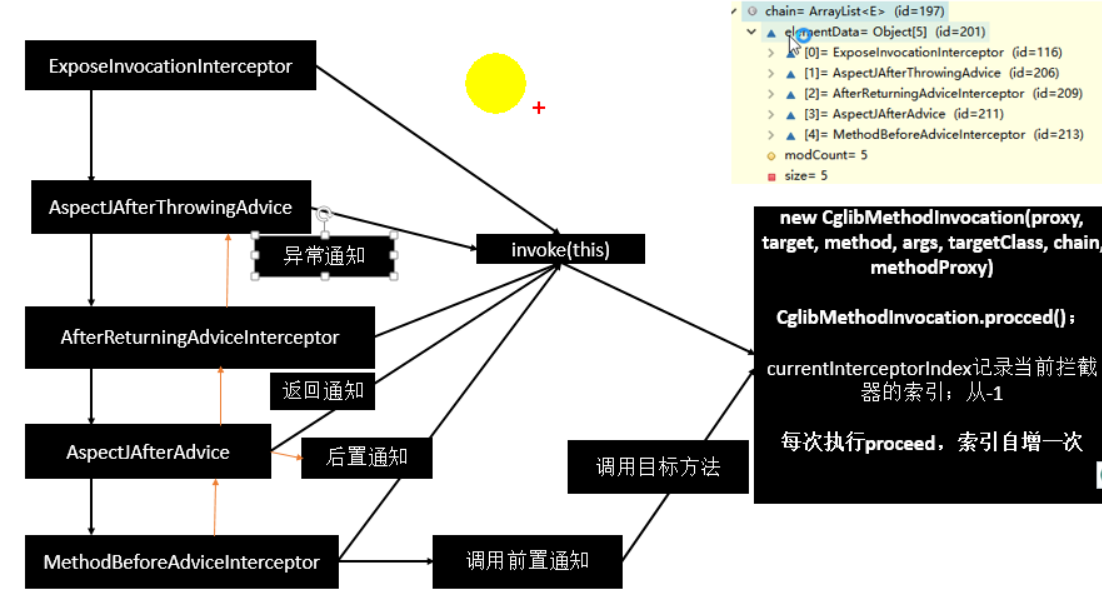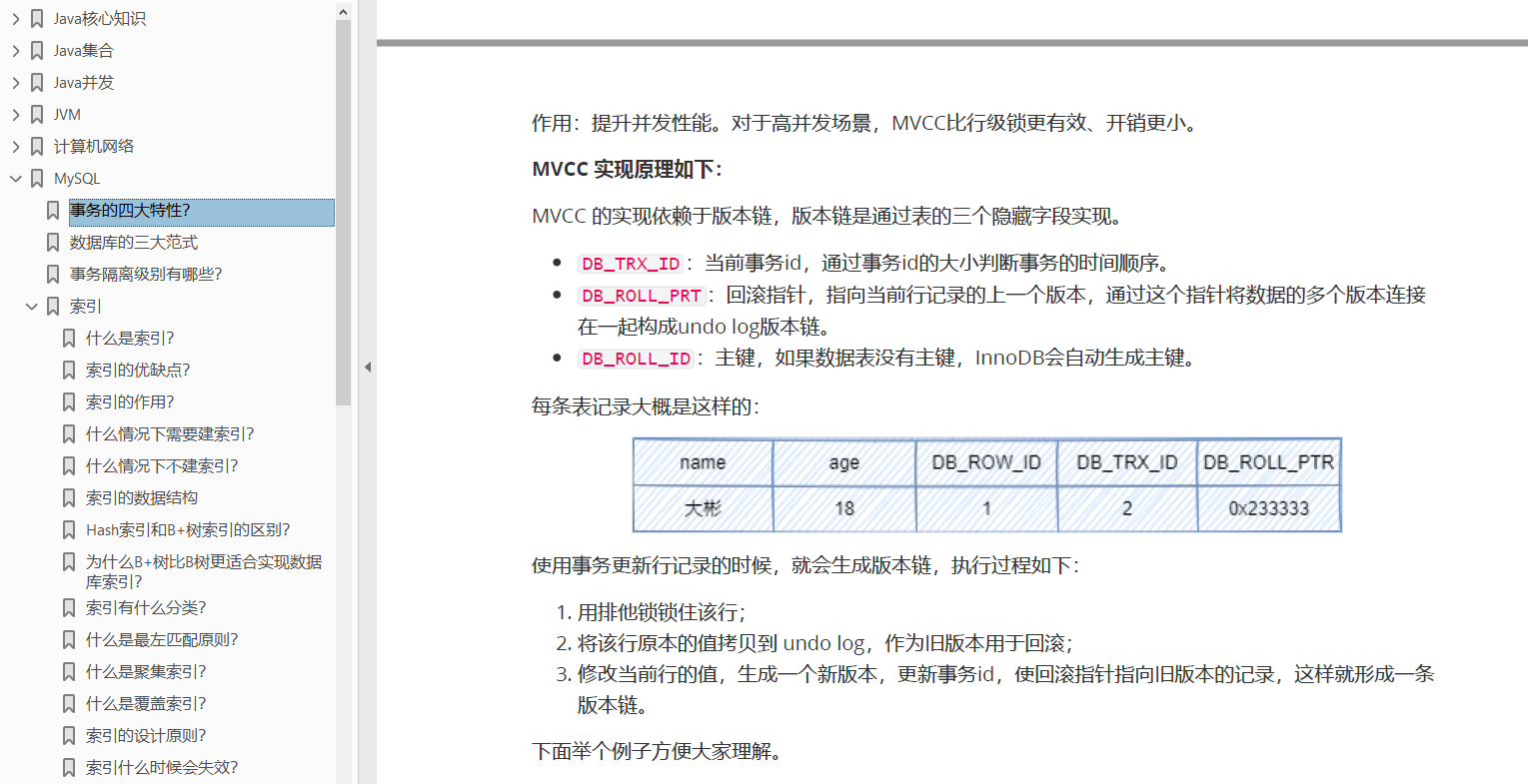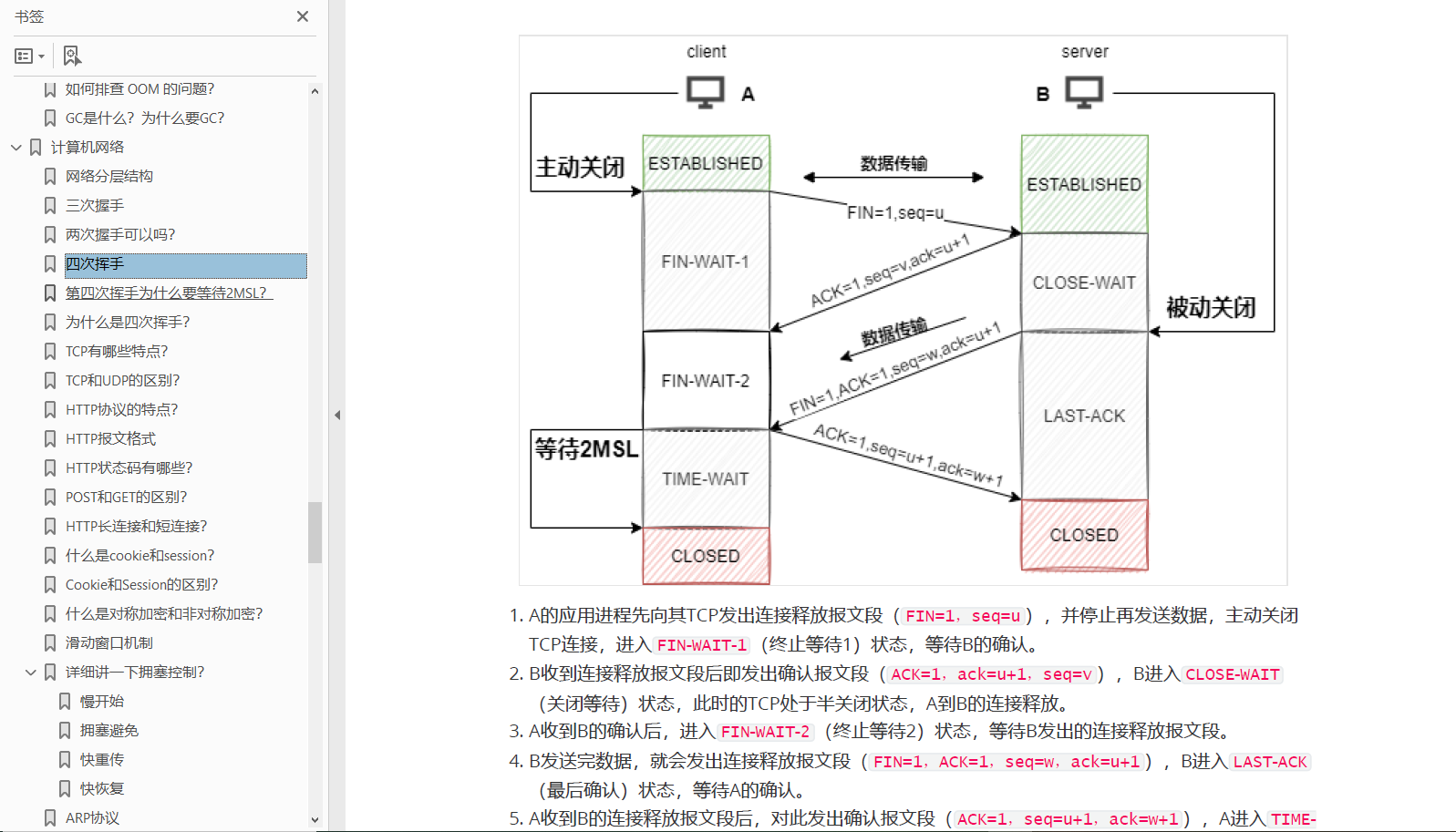Spring源码分析
正文
上一篇博文中我们讲了代理类的生成,这一篇主要讲解剩下的部分,当代理类调用时,目标方法和代理方法是如何执行的,我们还是接着上篇的ReflectiveMethodInvocation类Proceed方法来看。最全面的Java面试网站
public Object proceed() throws Throwable {
// 首先,判断是不是所有的interceptor(也可以想像成advisor)都被执行完了。
// 判断的方法是看currentInterceptorIndex这个变量的值,增加到Interceptor总个数这个数值没有,
// 如果到了,就执行被代理方法(invokeJoinpoint());如果没到,就继续执行Interceptor。
if (this.currentInterceptorIndex == this.interceptorsAndDynamicMethodMatchers.size() - 1) {
return invokeJoinpoint();
}
// 如果Interceptor没有被全部执行完,就取出要执行的Interceptor,并执行。
// currentInterceptorIndex先自增
Object interceptorOrInterceptionAdvice = this.interceptorsAndDynamicMethodMatchers.get(++this.currentInterceptorIndex);
// 如果Interceptor是PointCut类型
if (interceptorOrInterceptionAdvice instanceof InterceptorAndDynamicMethodMatcher) {
InterceptorAndDynamicMethodMatcher dm = (InterceptorAndDynamicMethodMatcher) interceptorOrInterceptionAdvice;
// 如果当前方法符合Interceptor的PointCut限制,就执行Interceptor
if (dm.methodMatcher.matches(this.method, this.targetClass, this.arguments)) {
// 这里将this当变量传进去,这是非常重要的一点
return dm.interceptor.invoke(this);
}
// 如果不符合,就跳过当前Interceptor,执行下一个Interceptor
else {
return proceed();
}
}
// 如果Interceptor不是PointCut类型,就直接执行Interceptor里面的增强。
else {
return ((MethodInterceptor) interceptorOrInterceptionAdvice).invoke(this);
}
}
我们先来看一张方法调用顺序图

我们看到链中的顺序是AspectJAfterThrowingAdvice、AfterReturningAdviceInterceptor、AspectJAfterAdvice、MethodBeforeAdviceInterceptor,这些拦截器是按顺序执行的,那我们来看看第一个拦截器AspectJAfterThrowingAdvice中的invoke方法
分享一份大彬精心整理的大厂面试手册,包含计算机基础、Java基础、多线程、JVM、数据库、Redis、Spring、Mybatis、SpringMVC、SpringBoot、分布式、微服务、设计模式、架构、校招社招分享等高频面试题,非常实用,有小伙伴靠着这份手册拿过字节offer~
需要的小伙伴可以自行下载:
AspectJAfterThrowingAdvice
@Override
public Object invoke(MethodInvocation mi) throws Throwable {
try {
//直接调用MethodInvocation的proceed方法
//从proceed()方法中我们知道dm.interceptor.invoke(this)传过来的参数就是ReflectiveMethodInvocation执行器本身
//这里又直接调用了ReflectiveMethodInvocation的proceed()方法
return mi.proceed();
}
catch (Throwable ex) {
if (shouldInvokeOnThrowing(ex)) {
invokeAdviceMethod(getJoinPointMatch(), null, ex);
}
throw ex;
}
}
第一个拦截器AspectJAfterThrowingAdvice的invoke方法中,直接调用mi.proceed();,从proceed()方法中我们知道dm.interceptor.invoke(this)传过来的参数就是ReflectiveMethodInvocation执行器本身,所以又会执行proceed()方法,拦截器下标currentInterceptorIndex自增,获取下一个拦截器AfterReturningAdviceInterceptor,并调用拦截器中的invoke方法,,此时第一个拦截器在invoke()方法的第七行卡住了,接下来我们看第二个拦截器的执行
AfterReturningAdviceInterceptor
@Override
public Object invoke(MethodInvocation mi) throws Throwable {
//直接调用MethodInvocation的proceed方法
Object retVal = mi.proceed();
this.advice.afterReturning(retVal, mi.getMethod(), mi.getArguments(), mi.getThis());
return retVal;
}
AfterReturningAdviceInterceptor还是直接调用mi.proceed(),又回到了ReflectiveMethodInvocation的proceed()方法中,此时AfterReturningAdviceInterceptor方法卡在第四行,接着回到ReflectiveMethodInvocation的proceed()方法中,拦截器下标currentInterceptorIndex自增,获取下一个拦截器AspectJAfterAdvice,并调用AspectJAfterAdvice中的invoke方法
AspectJAfterAdvice
@Override
public Object invoke(MethodInvocation mi) throws Throwable {
try {
//直接调用MethodInvocation的proceed方法
return mi.proceed();
}
finally {
invokeAdviceMethod(getJoinPointMatch(), null, null);
}
}
AspectJAfterAdvice还是直接调用mi.proceed(),又回到了ReflectiveMethodInvocation的proceed()方法中,此时AspectJAfterAdvice方法卡在第五行,接着回到ReflectiveMethodInvocation的proceed()方法中,拦截器下标currentInterceptorIndex自增,获取下一个拦截器MethodBeforeAdviceInterceptor,并调用MethodBeforeAdviceInterceptor中的invoke方法
MethodBeforeAdviceInterceptor
@Override
public Object invoke(MethodInvocation mi) throws Throwable {
//终于开始做事了,调用增强器的before方法,明显是通过反射的方式调用
//到这里增强方法before的业务逻辑执行
this.advice.before(mi.getMethod(), mi.getArguments(), mi.getThis());
//又调用了调用MethodInvocation的proceed方法
return mi.proceed();
}
第5行代码终于通过反射调用了切面里面的before方法,接着又调用mi.proceed(),我们知道这是最后一个拦截器了,此时this.currentInterceptorIndex == this.interceptorsAndDynamicMethodMatchers.size() - 1应该为true了,那么就会执行 return invokeJoinpoint();,也就是执行bean中的目标方法,接着我们来看看目标方法的执行
@Nullable
protected Object invokeJoinpoint() throws Throwable {
return AopUtils.invokeJoinpointUsingReflection(this.target, this.method, this.arguments);
}
@Nullable
public static Object invokeJoinpointUsingReflection(@Nullable Object target, Method method, Object[] args)
throws Throwable {
// Use reflection to invoke the method.
try {
ReflectionUtils.makeAccessible(method);
//直接通过反射调用目标bean中的method
return method.invoke(target, args);
}
catch (InvocationTargetException ex) {
// Invoked method threw a checked exception.
// We must rethrow it. The client won't see the interceptor.
throw ex.getTargetException();
}
catch (IllegalArgumentException ex) {
throw new AopInvocationException("AOP configuration seems to be invalid: tried calling method [" +
method + "] on target [" + target + "]", ex);
}
catch (IllegalAccessException ex) {
throw new AopInvocationException("Could not access method [" + method + "]", ex);
}
}
before方法执行完后,就通过反射的方式执行目标bean中的method,并且返回结果,接下来我们想想程序该怎么执行呢?
1 、MethodBeforeAdviceInterceptor执行完了后,开始退栈,AspectJAfterAdvice中invoke卡在第5行的代码继续往下执行, 我们看到在AspectJAfterAdvice的invoke方法中的finally中第8行有这样一句话 invokeAdviceMethod(getJoinPointMatch(), null, null);,就是通过反射调用AfterAdvice的方法,意思是切面类中的 @After方法不管怎样都会执行,因为在finally中
2、AspectJAfterAdvice中invoke方法发执行完后,也开始退栈,接着就到了AfterReturningAdviceInterceptor的invoke方法的第4行开始恢复,但是此时如果目标bean和前面增强器中出现了异常,此时AfterReturningAdviceInterceptor中第5行代码就不会执行了,直接退栈;如果没有出现异常,则执行第5行,也就是通过反射执行切面类中@AfterReturning注解的方法,然后退栈
3、AfterReturningAdviceInterceptor退栈后,就到了AspectJAfterThrowingAdvice拦截器,此拦截器中invoke方法的第7行开始恢复,我们看到在 catch (Throwable ex) { 代码中,也就是第11行 invokeAdviceMethod(getJoinPointMatch(), null, ex);,如果目标bean的method或者前面的增强方法中出现了异常,则会被这里的catch捕获,也是通过反射的方式执行@AfterThrowing注解的方法,然后退栈\
总结
这个代理类调用过程,我们可以看到是一个递归的调用过程,通过ReflectiveMethodInvocation类中Proceed方法递归调用,顺序执行拦截器链中AspectJAfterThrowingAdvice、AfterReturningAdviceInterceptor、AspectJAfterAdvice、MethodBeforeAdviceInterceptor这几个拦截器,在拦截器中反射调用增强方法
最后给大家分享一个Github仓库,上面有大彬整理的300多本经典的计算机书籍PDF,包括C语言、C++、Java、Python、前端、数据库、操作系统、计算机网络、数据结构和算法、机器学习、编程人生等,可以star一下,下次找书直接在上面搜索,仓库持续更新中~


如果访问不了Github,可以访问码云地址。

